
Wine Culture and Information since 2002 - Volume 22
 Wine Culture and Information since 2002 - Volume 22 |
|
RieslingCapable of giving its best in cool climates and with a good exposition to the sun, Riesling is among the most prestigious and elegant wines of the world whose wines are among the most longeval of the category |
|
Welcome to the prestigious world of refined and elegant white wines! Talking about Riesling - or better to say, about good wines made of Riesling - this is a consideration which certainly seems to be adequate. Riesling - whose origins are from Germany - is now considered an “international” grape highly praised for its extraordinary elegance, its class and, in particular, for the surprising capacity of aging of its wines which can magnificently improve for many years. In fact the best Rieslings, thanks to the high acidity of this grape and the remarkable quantity in extracts, can even age for some tens of years, practically a record shared with other very few examples of the same category. Riesling is pretty looked for both by wine lovers and producers, and despite the fact this grape gives its best in areas with a cool but sunny climate, today it is virtually present in every country of the world. It is not clear what was the exact area of origin of Riesling and the current theories suggest it could have been originated from the Rhein, Mosel or Palatinate (Pfalz) areas, all located in Germany. Historical and reliable documents tell that Riesling was known and widely cultivated in the areas along the course of Rhein since the fifteenth century, however other reliable sources suggest it was already cultivated in the ninth century because of an order of Ludwig the Germanic. Moreover other sources support the theory Riesling was already cultivated in Germany 2,000 years ago: in case this hypothesis is to be confirmed, Riesling should be considered among the most ancient grapes of this country together with Elbling, Silvaner and Räuschling. The importance of Riesling has been obscured by many other varieties obtained by crossing Riesling with other vines. This is the case of Müller Thurgau, whose notoriety was such that viticulturists uprooted Riesling from their vineyards and replaced it with this vine. In 1980 Riesling represented only 19% of the total acreage of Germany and ten years later - in 1990 - it was just 21%.
The rigid winters of the 1990's have however exalted the resistance qualities of Riesling as opposed to the “new species” and the efforts made in order to improve the quality of wines by the wineries which were historically producing Riesling, have contributed on the long run to the superiority of this important white berried grape. Riesling is a vine which tends to produce abundant yields and - surprisingly - it keeps remarkable levels of acidity even when reach full ripeness. The notoriety of Riesling is also because of the excellent results obtained by producers in Mosel-Saar-Ruwer - or Mosel in short - where about one third of all German Riesling is being produced. Riesling has also been used for creating new crossings and, in particular, with Silvaner it gave origin to many species of which the most famous ones are Müller Thurgau, Ehrenfelser and Scheurebe. Moreover the Incrocio Manzoni 6.0.13 grape - particularly common in north-eastern Italy - is the result of the crossing between Riesling and Pinot Blanc. Riesling is a variety having an excellent resistance to cold temperatures, for this reason it is the most cultivated grape in cool climate areas. However Riesling needs proper care and conditions in order to give its best. The quality of Riesling seems not to suffer of its tendency to produce abundant yields, however the best Rieslings are the ones produced with low yields harvests. Riesling is very resistant to winter frosts and it is a variety defined as late ripening, in fact the harvesting of its grapes - in the northern hemisphere - is usually done after the half of October and the beginning of November. Riesling has a small and pretty compact bunch and for this reason it is very sensitive to the effects of molds which frequently result in serious problems for viticulturists. In warm climate areas Riesling seems not to produce good results. In these areas the ripening of grapes is faster and this frequently influence the quality of wines by producing coarser and less elegant aromas. In cool climate areas - where Riesling can ripe slowly - this grape develops elegant aromas and intense flavors while keeping a high level of acidity. For this reason the best Riesling of the world are believed to be the ones from Germany and in particular the ones produced in the coolest areas of Mosel-Saar-Ruwer (Mosel). It is believed Riesling can give its best in slopes having an ideal inclination of 30° in order to take advantage of the incidence of sun rays and the heat reflected by the surface of rivers. Vineyards in Mosel producing the best Riesling are however exposed towards south and shielded by the cold winds in order to ensure the best ripening conditions of grapes. Riesling is now present in many countries of the world and it is frequently called with different name while remaining the very same variety. In the United States of America it is usually called Johannisberg Riesling and occasionally White Riesling or Rhine Riesling. In Italy is frequently called Riesling Renano and it should be observed the grape called Riesling Italico - known somewhere else as Welschriesling - has no connection with Riesling. Wines produced with Riesling probably represents the magnification of enology based on inert containers. In fact the majority of Riesling wines is produced without making use of any casks or barriques and despite the fact there are producers outside Germany who allow their Riesling to age in cask, this method represents, as a matter of fact, the minority. The styles of wines produced with Riesling are many, from dry wines to sweet wines, of which the best representatives certainly are Trockenbeerenauslese (TBA) and Eiswein. Thanks to Riesling acidity, this excellent German sweet wines are always well balanced and never sickly. It should however be observed the overall tendency in the production of Riesling wines is to diminish the quantity of residual sugar therefore producing dry wines. The alcoholic percentage in Riesling wines is generally low and rarely can be found a Riesling with a high alcohol percentage. For example, German Riesling usually has an alcoholic percentage of about 7-9% and even in other areas they rarely goes beyond 12%. Thanks to its remarkable acidity and to the high content in extracts, wines produced with Riesling can stand to long aging times in bottle and in higher quality wines it can also reach some tens of years while improving their organoleptic qualities. Wines of lesser quality rarely goes beyond three years of aging in bottle.
|
||||||||
|
The analysis of colors in wines produced with Riesling will consider the specific style of the wine. In young dry wines not aged in wood containers - that is the majority of cases - the color of Riesling wines will always show greenish yellow hues and nuances of the same color. Rarely in young dry wines can be observed straw or golden yellow colors saved when the wines were aged in wood containers such as the barrique. Riesling - when it is being produced with quality criteria and kept in optimal conditions - can be aged in bottle even for many years. In this case the color tends to show the usual development of any other white wine with straw or golden yellow hues. Pretty different considerations are to be made - of course - for sweet wines produced with Riesling, typically from Germany and Austria and in particular for Auslese, Trockenbeerenauslese and Eiswein styles. In these wines the typical color is golden yellow and as the concentration and the ripeness of grapes increases - as well as the aging time - they can easily get amber yellow color of remarkable intensity.
|
|
Among the amazing characteristics of Riesling we certainly find its aromas. However it should be remembered the best way to appreciate Riesling is waiting. Contrary to the majority of dry white wines - like to say the totality of them - young wines produced with Riesling usually reveal the common and typical aromas of other white wines, in short, young Rieslings could be confused among many other wines. We are not saying young Rieslings are not interesting according to an olfactory point of view, however it should be remembered Riesling can give its best after a proper aging in bottle in which its aromas get more intense and more complex. Young Rieslings produced with not fully ripen grapes or cultivated in cool climate areas, denote pretty “sour” fruity aromas of green apple, lemon, lime, cedar and citrus fruits, as well as floral aromas of hawthorn, jasmine, wistaria and chamomile. Wines produced in certain areas - such as German Mosel - also have mineral hints because of the soil which are added to the aromatic hints mentioned above. Rieslings produced with ripe grapes, or cultivated in warm climate areas, reveal more round and less sour aromas in which can be perceived peach, pear, grapefruit, apricot, apple as well as tropical fruit. Like we already said, wines produced with Riesling, both dry and sweet, can excellently age while improving their organoleptic qualities. With the aging Riesling wines develop aromas of butter, honey, wax as well as an elegant and looked for aroma of petrol oil and, even this can sound pretty strange, in Riesling wines is very pleasing. In sweet wines, and in particular in those produced with grapes affected with Botrytis Cinerea - or noble rot - can also be found aromas of spices, such as cinnamon, ginger and anise, aromas of musk, dried fruit, in particular dried apricot, walnut and almond, as well as fruit jams such as apricot and peach. Sometimes it is also possible to find vegetal and herbaceous aromas such as sage, thyme, nettle, tobacco and tea. Despite the fact this style of Riesling are not very common, in wines aged in cask - certainly a minority - can also be found aromas of vanilla and toasted wood.
|
||||
|
By considering the rich variety of styles produced with Riesling, the gustatory qualities of these wines are equally rich. In dry wines the acidity will be the most dominant taste as well as any possible mineral flavors: for these two characteristics - as well as the typical aromatic qualities - wines from German Mosel are usually defined as “wines of steel”. Despite the high - and certainly agreeable - acidity, these wines are however balanced, with a truly pleasing crispness. Acidity is also the essential factor which contributes in a determinant way to the balance of German sweet wines - such as Trockenbeerenauslese and Eiswein - while avoiding the remarkable sweetness to taste sickly. Alcohol in wines produced with Riesling is never too high - rarely is beyond 12% - and in German wines the typical alcohol level is of about 7-9%, whereas for sweet wines - in particular the ones produced with grapes affected by Botrytis Cinerea - the alcoholic percentage is even lesser, most of the times 6-7%. The gustatory elegance and the balance of these sweet wines remains however a solid reference point for the wines of this category.
|
|
Despite the fact Riesling is now spread in many wine countries of the world, its homeland - Germany - still remains the reference point for all the other producers. In this country Riesling is used for the production of many styles of wines, from dry wines to sweet ones. The best German Rieslings are certainly from Mosel-Saar-Ruwer - Mosel in short - followed by Palatinate (Pfalz), Rheingau, Nahe and Rheinhessen. Despite the German tradition is based on the production of wines having an appreciable quantity of residual sugar, the current tendency is to make very dry wines. However they are the wines belonging to the Kabinett, Spätlese and Auslese categories to catch the interest of wine lovers. These wines have a pretty low alcoholic percentage (7.5-9.5%) and an extraordinary balance between acidity, freshness and aromatic richness and certainly among the best representatives are the ones produced in Mosel, where today is being produced about 30% of German Riesling. In favorable years, wines produced in the Saar area are to be considered the best examples of Riesling of all Germany. In the central part of Mosel - at Bernkastel - Riesling wines are rounder and probably more immediate, whereas in the Ruwer area can be found Rieslings with intermediate styles between the two areas. The best wines of Mosel are also excellent when young, however it will be the aging in bottle to reveal their very best. In the Palatinate - thanks to a warmer climate - Riesling wines are more robust and spicy, whereas to the north - in the Rheinhessen - the style is rounder and smoother. In Rheingau are being produced excellent Riesling wines, elegant and refined of which the best examples are the ones having an appreciable residual sugar. In the Nahe area are found Rieslings that can be considered an in between style of Mosel and Rheingau. In Austria the best area for Riesling wine is Wachau where are being produced dry wines in the Smaragd style with alcohol percentages as high as 15.5%. In France Riesling offers excellent wines in Alsace, here produced in many styles - both sweet and dry - as well as in the Sélection de Grains Nobles and Vendange Tardive versions. New Zealand produces excellent Rieslings, in particular late harvests and wines produced with grapes affected by Botrytis Cinerea. Even in Australia the production of Riesling is remarkable and of high quality. Here the style is mainly for dry wines and with a very long aging potential, in particular the ones produced in Southern Australia in the areas of Clare Valley, Eden Valley and Adelaide Hills. Among other countries in which are produced wines with Riesling grapes there is Italy - in particular the Alto Adige region - Canada (mainly used for the production of Icewines) and United States of America in Washington and California states.
|
Wines of the Month |
|
|
|
Score legend Prices are to be considered as indicative. Prices may vary according to the country or the shop where wines are bought |
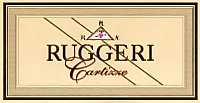
|
|
Prosecco di Valdobbiadene Superiore di Cartizze 2003 |
|
| Ruggeri (Italy) | |
| Grapes: Prosecco | |
| Price: € 12,40 | Score: |
| This sparkling wine shows a brilliant greenish yellow color and nuances of greenish yellow, very transparent, good effervescence, fine and persistent perlage. The nose denotes intense, clean, pleasing and refined aromas that start with hints of banana, pineapple and litchi followed by aromas of acacia, wistaria, broom, green apple, pear, peach and almond. In the mouth has good correspondence to the nose, a crisp and effervescent attack, however well balanced, delicate, intense flavors, agreeable. The finish is persistent with flavors of pear, banana and pineapple. A well made sparkling wine. This Prosecco ages on its lees for 2 months and ages in bottle for 3 months. | |
| Food Match: Pasta and risotto with vegetables, fish and crustaceans, Sauteed fish and crustaceans, Dairy products | |
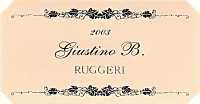
|
|
Prosecco di Valdobbiadene Giustino B. 2003 |
|
| Ruggeri (Italy) | |
| Grapes: Prosecco | |
| Price: € 10,20 | Score: |
| This sparkling wine shows a brilliant greenish yellow color and nuances of greenish yellow, very transparent, good effervescence, fine and persistent perlage. The nose reveals delicate, clean and pleasing aromas which start with hints of pear, apple and peach followed by aromas of pineapple, hawthorn, broom and litchi. In the mouth has good correspondence to the nose, a crisp and effervescent attack with slightly sweetness, however balanced, delicate, intense flavors, agreeable. The finish is persistent with flavors of pear and peach. This Prosecco is produced with the Charmat method and ages in bottle for 3 months. | |
| Food Match: Aperitifs, Vegetables and crustacean appetizers, Pasta and risotto with vegetables and crustaceans | |
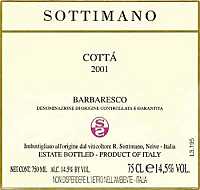
|
|
Barbaresco Cottà 2001 |
|
| Sottimano (Italy) | |
| Grapes: Nebbiolo | |
| Price: € 30,00 | Score: |
| This Barbaresco shows an intense ruby red color and nuances of garnet red, little transparency. The nose denotes intense, clean, pleasing, refined and elegant aromas which start with hints of black cherry and plum followed by aromas of blueberry, dried violet, licorice, tobacco, vanilla, mace, menthol and hints of coffee and cocoa. In the mouth has very good correspondence to the nose, a tannic attack and pleasing crispness, however balanced by alcohol, full body, intense flavors, good tannins. The finish is very persistent with long and good flavors of black cherry and plum. A well made wine. Barbaresco Cottà ages for 18-20 months in barrique. | |
| Food Match: Game, Stewed and braised meet, Roasted meat, Hard cheese | |
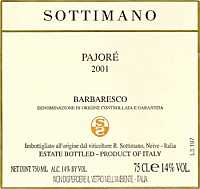
|
|
Barbaresco Pajorè 2001 |
|
| Sottimano (Italy) | |
| Grapes: Nebbiolo | |
| Price: € 30,00 | Score: |
| Barbaresco Pajorè shows an intense ruby red color and nuances of garnet red, little transparency. The nose reveals intense, clean, pleasing, refined and elegant aromas which start with hints of cherry and violet followed by aromas of blueberry, plum, dried rose, tobacco, licorice, vanilla, cinnamon, cocoa and hints of rubber. In the mouth has very good correspondence to the nose, a slightly tannic attack and however well balanced by alcohol, full body, intense flavors, good tannins, agreeable. The finish is very persistent with long flavors of cherry, plum and blueberry. A very well made wine. Barbaresco Pajorè ages for 18-20 months in barrique. | |
| Food Match: Stewed and braised meat, Game, Roasted meat, Hard cheese | |
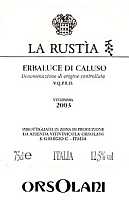
|
|
Erbaluce di Caluso La Rustia 2003 |
|
| Orsolani (Italy) | |
| Grapes: Erbaluce | |
| Price: € 8,90 | Score: |
| The wine shows a brilliant greenish yellow color and nuances of greenish yellow, very transparent. The nose reveals intense, clean, pleasing and refined aromas which start with hints of pear, litchi and honey followed by aromas of apple, peach, hawthorn, pineapple, broom, lemon and hints of mineral. In the mouth has good correspondence to the nose, a crisp attack and however balanced by alcohol, delicate, intense flavors, agreeable. The finish is persistent with flavors of peach, pear and lemon. A small part of this wine ferments in cask. | |
| Food Match: Fish appetizers, Dairy products, Eggs, Pasta and risotto with crustaceans and vegetables | |
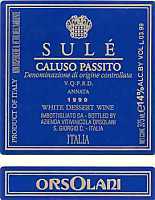
|
|
Caluso Passito Sulè 1999 |
|
| Orsolani (Italy) | |
| Grapes: Erbaluce | |
| Price: € 8,90 | Score: |
| This wine shows a brilliant amber yellow color and nuances of amber yellow, transparent. The nose reveals intense, clean, pleasing and elegant aromas which start with hints of dried fig and honey followed by aromas of dried apricot, candied fruit, quince jam, peach jam, date, orange marmalade, hazelnut, vanilla, saffron and hints of enamel. In the mouth has good correspondence to the nose, a sweet and round attack however well balanced, good body, intense flavors, agreeable. The finish is persistent with flavors of dried fig, honey and peach jam. A well made wine. Sulè ages for three years in barrique followed by one year of aging in bottle. | |
| Food Match: Confectionery, Hard and piquant cheese, Jam tarts | |
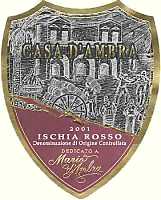
|
|
Ischia Rosso Riserva Mario D'Ambra 2000 |
|
| Casa D'Ambra (Italy) | |
| Grapes: Guarnaccia (50%), Piedirosso (Per' 'e Palummo) (50%) | |
| Price: € 14,50 | Score: |
| The wine shows an intense ruby red color and nuances of garnet red, little transparency. The nose reveals intense, clean, pleasing and refined aromas which start with hints of plum and black cherry followed by aromas of blackberry, licorice, violet, tobacco, vanilla and hints of cocoa and cinnamon. In the mouth has good correspondence to the nose, a slightly tannic attack and pleasing roundness, however balanced by alcohol, good body, intense flavors, good tannins. The finish is persistent with flavors of plum and black cherry. A well made wine. This reserve is aged in cask. | |
| Food Match: Broiled meat and barbecue, Stewed meat with mushrooms, Roasted meat | |
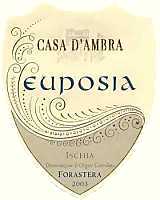
|
|
Ischia Forastera Euposia 2003 |
|
| Casa D'Ambra (Italy) | |
| Grapes: Forastera | |
| Price: € 7,80 | Score: |
| This wine shows an intense straw yellow color and nuances of greenish yellow, very transparent. The nose reveals intense, clean, pleasing and refined aromas which start with hints of pear and grapefruit followed by aromas of citrus fruit, hawthorn, broom, apple and plum. In the mouth has good correspondence to the nose, a crisp attack and pleasing sapidity, however balanced by alcohol, good body, intense flavors, agreeable. The finish is persistent with flavors of apple, pear and plum. | |
| Food Match: Broiled fish, Pasta and risotto with fish and vegetables, Sauteed fish | |
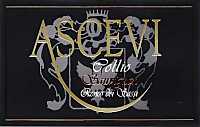
|
|
Collio Sauvignon Ronco dei Sassi 2003 |
|
| Ascevi Luwa (Italy) | |
| Grapes: Sauvignon Blanc | |
| Price: € 15,65 | Score: |
| This wine shows an intense straw yellow color and nuances of greenish yellow, very transparent. The nose denotes intense, clean, pleasing and refined aromas which start with hints of peach, elder and pineapple followed by good aromas of banana, passion fruit, broom, litchi, pear and hints of tomato leaf. In the mouth has good correspondence to the nose, a crisp attack and however well balanced by alcohol, good body, intense flavors, agreeable. The finish is persistent with flavors of peach, pineapple, litchi and passion fruit. A well made wine. This Sauvignon Blanc ages in steel tanks until the moment of bottling. | |
| Food Match: Fried fish, Pasta and risotto with crustaceans and fish, Vegetables soups, Eggs | |
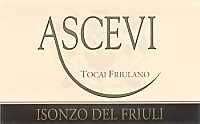
|
|
Friuli Isonzo Tocai Friulano 2003 |
|
| Ascevi Luwa (Italy) | |
| Grapes: Tocai Friulano | |
| Price: € 9,00 | Score: |
| This wine shows a pale straw yellow color and nuances of greenish yellow, very transparent. The nose reveals intense, clean, pleasing and refined aromas that start with hints of plum, hawthorn and grapefruit followed by aromas of apple, pear, broom, peach and pineapple. In the mouth has good correspondence to the nose, a crisp attack and pleasing roundness, however balanced by alcohol, good body, intense flavors, agreeable. The finish is persistent with flavors of plum, pear and pineapple. This wine ages in steel tanks until the moment of bottling. | |
| Food Match: Sauteed and broiled fish, Pasta and risotto with fish, Sauteed meat | |
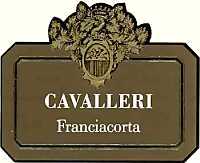
|
|
Franciacorta Pas Dosé 2000 |
|
| Cavalleri (Italy) | |
| Grapes: Chardonnay | |
| Price: € 18,50 | Score: |
| This Franciacorta shows an intense straw yellow color and nuances of golden yellow, very transparent, good effervescence, fine and persistent perlage. The nose reveals good personality with intense, clean, pleasing and elegant aromas which start with hints of yeast, grapefruit and citrus fruit peel followed by aromas of hawthorn, banana, bread crust, apple, hazelnut, praline and plum. In the mouth has good correspondence to the nose, a crisp and effervescent attack with pleasing roundness, however balanced, good body, intense flavors, agreeable. The finish is persistent with flavors of plum, grapefruit and banana. A small part of the cuvée ferments and ages in barrique. This Franciacorta ages for at least 36 months on lees. | |
| Food Match: Roasted fish and crustaceans, Pasta and risotto with fish and crustaceans, Roasted white meat | |
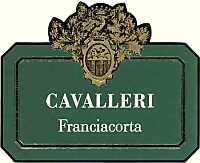
|
|
Franciacorta Satèn 2000 |
|
| Cavalleri (Italy) | |
| Grapes: Chardonnay | |
| Price: € 19,50 | Score: |
| This sparkling wine shows a brilliant straw yellow color and nuances of straw yellow, very transparent, good effervescence, fine and persistent perlage. The nose reveals intense, clean, pleasing, refined and elegant aromas which start with hints of yeast, bread crust and grapefruit followed by aromas of banana, brioche, apple, hazelnut, butter and plum. In the mouth has good correspondence to the nose, a crisp and effervescent attack, however well balanced, good body, intense flavors, agreeable. The finish is persistent with flavors of plum, grapefruit and hazelnut. A well made Franciacorta. Part of the cuvée ferments and ages in barrique. This Franciacorta ages for at least 36 months on lees. | |
| Food Match: Fried fish, Broiled fish and crustaceans, Pasta and risotto with fish and crustaceans, Sauteed white meat | |
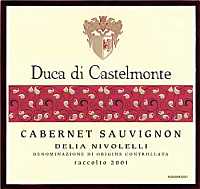
|
|
Delia Nivolelli Cabernet Sauvignon Duca di Castelmonte 2001 |
|
| Carlo Pellegrino (Italy) | |
| Grapes: Cabernet Sauvignon | |
| Price: € 9,30 | Score: |
| This wine shows an intense ruby red color and nuances of garnet red, little transparency. The nose reveals intense, clean, pleasing and refined aromas which start with hints of black cherry, violet and blackberry followed by aromas of black currant, blueberry, plum, licorice, vanilla and hints of menthol. In the mouth has good correspondence to the nose, a slightly tannic attack and however balanced by alcohol, good body, intense flavors, good tannins, agreeable. The finish is persistent with flavors of blackberry, black cherry and plum. This wine ages for 12 months in barrique. | |
| Food Match: Roasted meat, Stewed and braised meat, Hard cheese | |
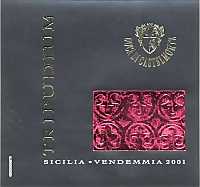
|
|
Tripudium Duca di Castelmonte 2001 |
|
| Carlo Pellegrino (Italy) | |
| Grapes: Nero d'Avola, Cabernet Sauvignon, Syrah | |
| Price: € 16,00 | Score: |
| This wine shows an intense ruby red color and nuances of garnet red, little transparency. The nose reveals intense, clean, pleasing and refined aromas which start with hints of black cherry and plum followed by aromas of blueberry, black currant, licorice, violet, vanilla and hints of mace and menthol. In the mouth has good correspondence to the nose, a slightly tannic attack and pleasing roundness, however balanced by alcohol, full body, intense flavors, good tannins. The finish is persistent with flavors of black cherry, plum and blueberry. A well made wine. Tripudium is aged for 12 months in barrique. | |
| Food Match: Roasted meat, Braised and stewed meat, Game, Hard cheese | |
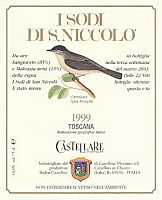
|
|
I Sodi di San Niccolò 1999 |
|
| Castellare di Castellina (Italy) | |
| Grapes: Sangiovese (85%), Malvasia Nera (15%) | |
| Price: € 42,00 | Score: |
| The wine shows a deep ruby red color and nuances of ruby red, little transparency. The nose reveals intense, clean, pleasing, refined and elegant aromas which start with hints of plum and black cherry followed by aromas of blueberry, blackberry, violet, licorice, tobacco, cocoa, cinnamon, vanilla and menthol. In the mouth has good correspondence to the nose, a slightly tannic attack and however well balanced by alcohol, full body, intense flavors, good tannins. The finish is persistent with flavors of plum, black cherry and blueberry. A well made wine. I Sodi di San Niccolò ages for 15-30 months in barrique followed by 12 months of aging in bottle. | |
| Food Match: Braised and stewed meat, Game, Roasted meat, Hard cheese | |
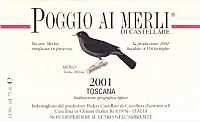
|
|
Poggio ai Merli 2001 |
|
| Castellare di Castellina (Italy) | |
| Grapes: Merlot | |
| Price: € 58,00 | Score: |
| Poggio ai Merli shows a deep ruby red color and nuances of ruby red, little transparency. The nose reveals personality with intense, clean, pleasing, refined and elegant aromas which start with good hints of plum, black cherry and rhubarb followed by good aromas of blackberry, black currant, dried violet, licorice, tobacco, vanilla, nutmeg and hints of cinchona and bell pepper. In the mouth has very good correspondence to the nose, a slightly tannic attack and pleasing smoothness, however well balanced by alcohol, full body, intense flavors, good tannins, very agreeable. The finish is very persistent with long and good flavors of black cherry, plum and black currant. A great and very well made wine. Poggio ai Merli ages for 15-30 months in barrique followed by 12 months of aging in bottle. | |
| Food Match: Braised and stewed meat, Game, Roasted meat, Hard cheese | |
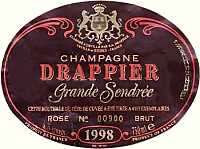
|
|
Champagne Grande Sendrée Rosé 1998 |
|
| Drappier (France) | |
| Grapes: Pinot Noir | |
| Price: € 51,80 | Score: |
| This Champagne shows a brilliant salmon pink color and nuances of salmon pink, very transparent, good effervescence, fine and persistent perlage. The nose reveals intense, clean, pleasing, refined and elegant aromas which start with hints of raspberry, cherry and yeast followed by aromas of tangerine, banana, brioche, butter, bread crust, hazelnut, dried rose, orange peel and hints of cinnamon. In the mouth has good correspondence to the nose, a crisp and effervescent attack, however well balanced, good body, intense flavors, agreeable. The finish is persistent with flavors of raspberry, cherry and tangerine. A well made Champagne. Grande Sendrée Rosé is produced with the bleeding technique (saignée). | |
| Food Match: Roasted fish, Stuffed pasta, Roasted meat, Broiled Fish and Crustaceans | |
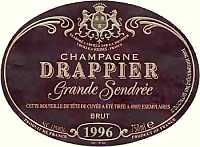
|
|
Champagne Grande Sendrée Brut 1996 |
|
| Drappier (France) | |
| Grapes: Pinot Noir (55%), Chardonnay (45%) | |
| Price: € 43,50 | Score: |
| This Champagne shows a brilliant golden yellow color and nuances of golden yellow, very transparent, good effervescence, fine and persistent perlage. The nose reveals good personality with intense, clean, pleasing, refined and elegant aromas which start with good hints of bread crust, honey and yeast followed by good aromas of banana, brioche, pineapple, butter, apple, litchi, grapefruit, orange peel, praline and hints of flint. In the mouth has very good correspondence to the nose, a crisp and effervescent attack with pleasing smoothness, however well balanced, good body, intense flavors, agreeable. The finish is very persistent with long flavors of honey, banana, grapefruit and brioche. A great Champagne. | |
| Food Match: Roasted fish, Stewed fish, Roasted meat, Stuffed pasta | |
|
||||||||
|
DiWineTaste Polls
|
| |||||||
Privacy Policy | |||||||


| Copyright © 2002-2024 Antonello Biancalana, DiWineTaste - All rights reserved |
| All rights reserved under international copyright conventions. No part of this publication and of this WEB site may be
reproduced or utilized in any form or by any means, electronic or mechanical, without permission in writing from DiWineTaste. |